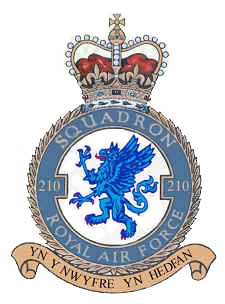
No. 578 Squadron RAF was a heavy bomber squadron of the Royal Air Force during the Second World War.
No. 635 Squadron RAF was a heavy bomber squadron of the Royal Air Force during the Second World War.
No. 630 Squadron RAF was a heavy bomber squadron of the Royal Air Force during the Second World War.
No. 623 Squadron RAF was a heavy bomber squadron of the Royal Air Force during the Second World War.
No. 619 Squadron RAF was a heavy bomber squadron of the Royal Air Force during the Second World War, flying Lancaster bombers from bases in Lincolnshire.
No. 692 Squadron RAF was a light bomber squadron of the Royal Air Force during the Second World War.

No. 102 Squadron was a Royal Air Force night bomber squadron in World War I and a heavy bomber squadron in World War II. After the war it flew briefly as a transport squadron before being reformed a light bomber unit with the Second Tactical Air Force within RAF Germany. Its last existence was as a Thor strategic missile unit.
No. 625 Squadron RAF was a heavy bomber squadron of the Royal Air Force during the Second World War.
No. 626 Squadron RAF was a heavy bomber squadron of the Royal Air Force from 1943 to 1945.
No. 513 Squadron RAF was a non-operational bomber squadron of the Royal Air Force in 1943.

Number 207 Squadron is an historic bomber squadron and, latterly, a communications and flying training squadron of the Royal Air Force, most recently based at RAF Linton-on-Ouse in Yorkshire, operating Short Tucano T.1 trainer aircraft.

No. 210 Squadron was a Royal Air Force unit established in World War I. Disbanded and reformed a number of times in the ensuing years, it operated as a fighter squadron during World War I and as a maritime patrol squadron during the Spanish Civil War, World War II and the Cold War before it was last deactivated in 1971.
No. 158 Squadron RAF was a World War I proposed ground attack squadron that did not became operational in time to see action, and a World War II bomber squadron. After World War II had ended in Europe the squadron operated in the transport role until disbandment in December 1945.
No. 570 Squadron RAF was a bomber unit active within No. 38 Group RAF as an airborne, bomber support and special operations squadron during World War II.
No. 608 Squadron was an Auxiliary Air Force squadron of the Royal Air Force during the Second World War. It flew during its existence as a bomber, fighter and reconnaissance unit and was the only RAF squadron to be equipped with the unsuccessful Blackburn Botha torpedo bomber.

No. 576 Squadron RAF was a Royal Air Force Second World War heavy bomber squadron.

No. 550 Squadron RAF was a heavy bomber squadron of the Royal Air Force during World War II. Formed at RAF Waltham on 25 November 1943, 550 Squadron flew Avro Lancaster bombers as part of No. 1 Group RAF. In early 1944, the squadron was moved to RAF North Killingholme, Lincolnshire where it continued operations until May 1945, when it began dropping food over the Netherlands as a relief effort as part of Operation Manna. The squadron was disbanded on 31 October 1945. Today, a surviving Lancaster bomber continues to fly in the markings of BQ-B "Phantom of the Ruhr" EE139 from 550 squadron as part of the Battle of Britain Memorial Flight.
No. 571 Squadron RAF was a Second World War Royal Air Force pathfinder squadron operating the de Havilland Mosquito.

No. 627 Squadron was a Royal Air Force Mosquito aircraft pathfinder bomber squadron that operated during the Second World War.

No. 156 Squadron RAF was a Royal Air Force Squadron that was active as a bomber unit in World War II.








